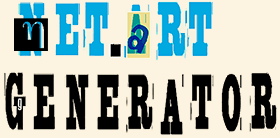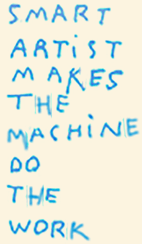A SMART ARTIST MAKES THE MACHINE DO THE WORK!
net.art generator: What it is and where it comes from
The net.art generator is a computer program which collects and recombines material from the Internet to create a new website or a new image. The WWW-interface of the easy-to-use program requires the user to enter a title which then functions as
the search term, and to enter a name as author. The resulting images and websites are stored online in an archive from where recent results can be downloaded. The complete archive is only available to the artist. Since 1997 five different
versions of the net.art generator have been realized in collaboration with seven programers: nag_01 to nag_05. A predecessor of the net.art generator has been in use for the project Female
Extension
Although it would be possible to solve the type of problem which the net.art generator addresses by using other programing languages, all the programers so far have chosen PERL (a scripting language). One reason for this might be that it has been
quite popular within the hacker scene as it is free software and compatible with other free software. Furthermore, the Comprehensive Perl Archive Network (CPAN) contains a huge number of modules which can be used as basic elements for the net.art
generator.
The PERL script itself is very stable and reliable, but its functionality highly depends on the connected search engines. This is where the fun – and the trouble – originates. In the course of its existence the different versions of the nag have
used a number of available search engines, but it has become harder and harder over time to get free access to search engine results (via their APIs). This is also the reason why the last remaining net.art generator, nag_05, has been out of order
for many months: Google, the connected search engine, has changed their terms of use in 2015 and terminated the free access to their search results. In the meantime we have restored nag_05 [Link to: nag.iap.de] by using a free but very limited
offer by Google (100 requests per day).
Historical Overview
The interfaces of the different versions, examples of their results and their source code you can find here.
The first net.art generator nag_01 was developed in 1997 in collaboration with Ryan Johnston from Banff Media Center, Canada. nag_01 loads one or several selected suitable images in the background, and then adds layers containing text and
single images on top of it. The result is a new website which often looks like a graphic design.
nag_02 was implemented by the Slovenian hacker Luka Frelih also in 1997. On my suggestion he followed Andrew Bulhak's Dada-Engine. It took up to 30 minutes for the very complex PERL script to produce its result, which was mainly
characterized by the surprising creation of new words or combinations of words, and by little use of images. The resulting websites consisted of a number of inter-linked webpages.
nag_03 was programed by Hamburg-based hackers Barbara Thoens and Ralf Prehn in 1999. Compared to more complex versions of net.art generator, this simple and robust script was easy to use and stable for a long time. It mainly processed
images.
nag_04 (also known as moiNAG) was conceived and realised in 2003 by programer Richard Leopold. The program shows structural similarities to nag_02 by also following Bulhak's Dada-Engine. It focuses on text processing although it is also
possible to integrate images into the new websites. Markov chains are used to "write" the texts. A special feature of nag_04 is that it calculates the formatting tags for the new website from tags of the found websites. Here is an interview with the programer.
nag_05 is a version of the program which reworks images only. The related search-engine Google Images provides the material. I developed the concept for nag_05 in 2003 in close collaboration with the programer Panos Galanis, from Hamburg
based company iap. Parts of the found images are manipulated and recombined with the help of a random-generator driven collage technique. The images are processed by ImageMagick on the server and the result is a new image.
Since 2003 the code of all net.art generator is available under GPL (GNU General Public License) on the project's homepage.
Special thanks to all programers for their enthusiasm and commitment.
For further reading, exhibition views and reviews pls visit this website.

